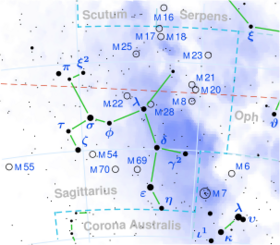Astronomy:4 Sagittarii
| Observation data Equinox J2000.0]] (ICRS) | |
|---|---|
| Constellation | Sagittarius |
| Right ascension | 17h 59m 47.55132s[1] |
| Declination | −23° 48′ 58.0269″[1] |
| Apparent magnitude (V) | 4.74[2] |
| Characteristics | |
| Spectral type | B9V[3] |
| U−B color index | −0.03[4] |
| B−V color index | -0.05[4] |
| Astrometry | |
| Radial velocity (Rv) | −18.00[5] km/s |
| Proper motion (μ) | RA: +3.673[1] mas/yr Dec.: −50.327[1] mas/yr |
| Parallax (π) | 8.3677 ± 0.4521[1] mas |
| Distance | 390 ± 20 ly (120 ± 6 pc) |
| Absolute magnitude (MV) | −0.77[2] |
| Details | |
| Mass | 3.23[6] M☉ |
| Luminosity | 240[6] L☉ |
| Temperature | 9,661[6] K |
| Rotational velocity (v sin i) | 149[6] km/s |
| Other designations | |
| Database references | |
| SIMBAD | data |
4 Sagittarii is a suspected astrometric binary[8] star system in the zodiac constellation of Sagittarius, located approximately 390 light years away based on parallax.[1] It is visible to the naked eye as a faint, blue-white hued star with an apparent visual magnitude of 4.74,[2] The system is moving closer to the Earth with a heliocentric radial velocity of −18 km/s.[5]
The visible component is a B-type main-sequence star with a stellar classification of B9 V.[3] It has a high rate of spin, displaying a projected rotational velocity of 149 km/s.[6] This is giving it an oblate shape with an equatorial bulge that is an estimated 14% larger than the polar radius.[9] 4 Sagittarii has 3.23 times the mass of the Sun and is radiating 240 times the Sun's luminosity from its photosphere at an effective temperature of 9,661 K.[6]
References
- ↑ 1.0 1.1 1.2 1.3 1.4 1.5 Brown, A. G. A. (August 2018). "Gaia Data Release 2: Summary of the contents and survey properties". Astronomy & Astrophysics 616: A1. doi:10.1051/0004-6361/201833051. Bibcode: 2018A&A...616A...1G. Gaia DR2 record for this source at VizieR.
- ↑ 2.0 2.1 2.2 Anderson, E.; Francis, Ch. (2012). "XHIP: An extended hipparcos compilation". Astronomy Letters 38 (5): 331. doi:10.1134/S1063773712050015. Bibcode: 2012AstL...38..331A. Vizier catalog entry
- ↑ 3.0 3.1 Hoffleit, D.; Warren, W. H. (1995). "VizieR Online Data Catalog: Bright Star Catalogue, 5th Revised Ed. (Hoffleit+, 1991)". VizieR On-line Data Catalog: V/50. Originally Published in: 1964BS....C......0H 5050. Bibcode: 1995yCat.5050....0H.
- ↑ 4.0 4.1 Mallama, A. (2014). "Sloan Magnitudes for the Brightest Stars". The Journal of the American Association of Variable Star Observers 42 (2): 443. Bibcode: 2014JAVSO..42..443M.Vizier catalog entry
- ↑ 5.0 5.1 Gontcharov, G. A. (2006). "Pulkovo Compilation of Radial Velocities for 35 495 Hipparcos stars in a common system". Astronomy Letters 32 (11): 759–771. doi:10.1134/S1063773706110065. Bibcode: 2006AstL...32..759G.
- ↑ 6.0 6.1 6.2 6.3 6.4 6.5 Zorec, J.; Royer, F. (2012). "Rotational velocities of A-type stars". Astronomy & Astrophysics 537: A120. doi:10.1051/0004-6361/201117691. Bibcode: 2012A&A...537A.120Z. Vizier catalog entry
- ↑ "4 Sgr". SIMBAD. Centre de données astronomiques de Strasbourg. http://simbad.u-strasbg.fr/simbad/sim-basic?Ident=4+Sgr.
- ↑ Eggleton, P. P.; Tokovinin, A. A. (2008). "A catalogue of multiplicity among bright stellar systems". Monthly Notices of the Royal Astronomical Society 389 (2): 869–879. doi:10.1111/j.1365-2966.2008.13596.x. Bibcode: 2008MNRAS.389..869E.
- ↑ van Belle, Gerard T. (March 2012). "Interferometric observations of rapidly rotating stars". The Astronomy and Astrophysics Review 20 (1): 51. doi:10.1007/s00159-012-0051-2. Bibcode: 2012A&ARv..20...51V.
 |


